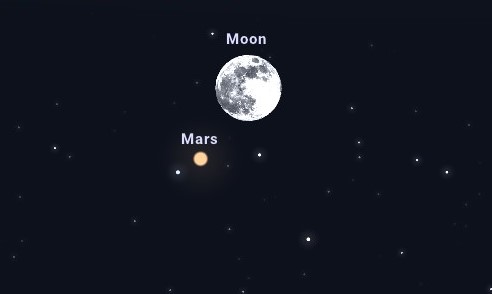COSMIC HOLIDAY FEAST
One of my oldest and fondest memories as a stargazer was when a thin crescent moon covered Venus early on the morning of July 31, 1974, as seen from my home in the Chicago area. My almost thirteen year old self dragged my mom out of bed to see it, just before dawn. This month will feature a somewhat similar event, actually in the evening sky, as we will see below.
Our “star” of the month is Mars. About once every 27 months, our planet passes Mars, and the Red Planet is closer than usual to Earth and appears opposite the Sun in the sky- visible all night long, rising in the east near sunset, highest near midnight, and setting in the west near sunrise. Although Earth’s orbit is nearly circular, that of Mars is not, This causes the distance between the two planets to vary from 35-63 million miles when Mars is at opposition. This year, the closest that Earth and Mars will get to each other will be some 50,000,000 miles near December 7, but since we are on a downward cycle of oppositions, Mars will not appear so bright again until the year 2033. Near its peak, Mars will outshine all nighttime objects except the Moon and Jupiter, shining brightly with a reddish-orange hue due to oxidation on its surface.

Facing east, 8 pm St. Louis time, Wednesday December 7. The Full Moon will occult (cover) Mars between 9:05-9:51 pm. Start watching a few minutes before these times. Mars will look like a bright “star” so not to scale. Binoculars or a telescope show the occultation better. Courtesy of Stellarium.
The Moon also goes through opposition every month when it is full. Amazingly, the night of the December full moon this year is also the 7th. In fact, the Moon will pass right in front of Mars that night as seen from the St. Louis area! This rare occultation of Mars should be seen with the unaided eye, although the view will be much improved with binoculars or a telescope. The time of disappearance will be around 9:05 pm, and it might take a few seconds for Mars to fade from view, so watch closely. The reappearance is scheduled for 9:51 pm, St. Louis time. Start watching a few minutes before these times in order to be safe. I have been watching the skies for just over fifty years, and I can remember seeing only three or four occultations of planets, but none of Mars, so let’s hope the night of December 7th is clear!
The other holiday treat available this month is a chance to view all five bright planets at the same time, in the evening sky soon after sunset. Jupiter is the brilliant object adorning the southern part of the sky during December early evenings, with twice-as-distant Saturn appearing as the next fairly bright “star” to the lower right during the early evening. Mars, as already discussed, shines brightly, looking somewhat orange in the east. Although these three planets should be unmistakable, the two innermost planets can also be glimpsed this month. The biggest requirement to do this is find a spot with an open view to the west- southwest horizon. Bring a pair of binoculars to spot Venus early in December, and they will be helpful to find Mercury at all. Go out about 30-45 minutes after sunset, or around 5:20-5:40 pm, and look very low in the sky. If you don’t live near St. Louis, look up your times of local sunset.
If the night is clear and you have that open horizon, you should be able to spot Venus without too much trouble. It actually outshines all of the other planets by far but is dimmed heavily this month due to being seen against the glow of twilight. From around Dec. 9-29, best around the 15th-25th, Mercury should be visible in binoculars to the upper left of Venus, but much dimmer. If you can easily spot Mercury in the binoculars, note the spot on the horizon above which it appears, and see if you can see it without optical aid. The picture below shows the view beginning on the night of Christmas Eve, when a beautiful, thin crescent moon will appear close by. Mercury will appear to close in on Venus, nearest on the nights of the 28th & 29th, but by then will appear quite a bit fainter than it did before Christmas. This is due to Mercury turning its lit side away from us and dropping towards the horizon as it passes more and more between the Earth and Sun. As shown in the picture, the Moon will go on to pass our other planets over the next several days after Christmas and into the new year 2023.

Follow the moon when as a thin crescent, it forms a triangle with Venus and Mercury low in the western sky on Christmas eve. Binoculars might help. Each night, the Moon becomes thicker and moves on, passing Saturn, Jupiter, and Mars between Dec. 26- Jan. 3. Courtesy of Stellarium.
These five planets will all have different destinies in terms of their visibility this winter and spring. Mercury will be gone by the end of December, while Venus will become a fine “evening star”, gracing our skies until July. Saturn and Jupiter will fall behind Earth and appear to drop towards the western horizon as the weeks pass. On their way out, both will pass Venus- Saturn near January 22nd and Jupiter near the first of March. The current apparition of Mars, after its impressive peak early this month, will slowly sputter to a conclusion next summer, when Mars will shine just 1/30 as bright as it will in early December.
The Gateway to the Stars program, featuring monthly educational programs followed by free telescope viewing on our West Entrance Plaza, will resume next May.
